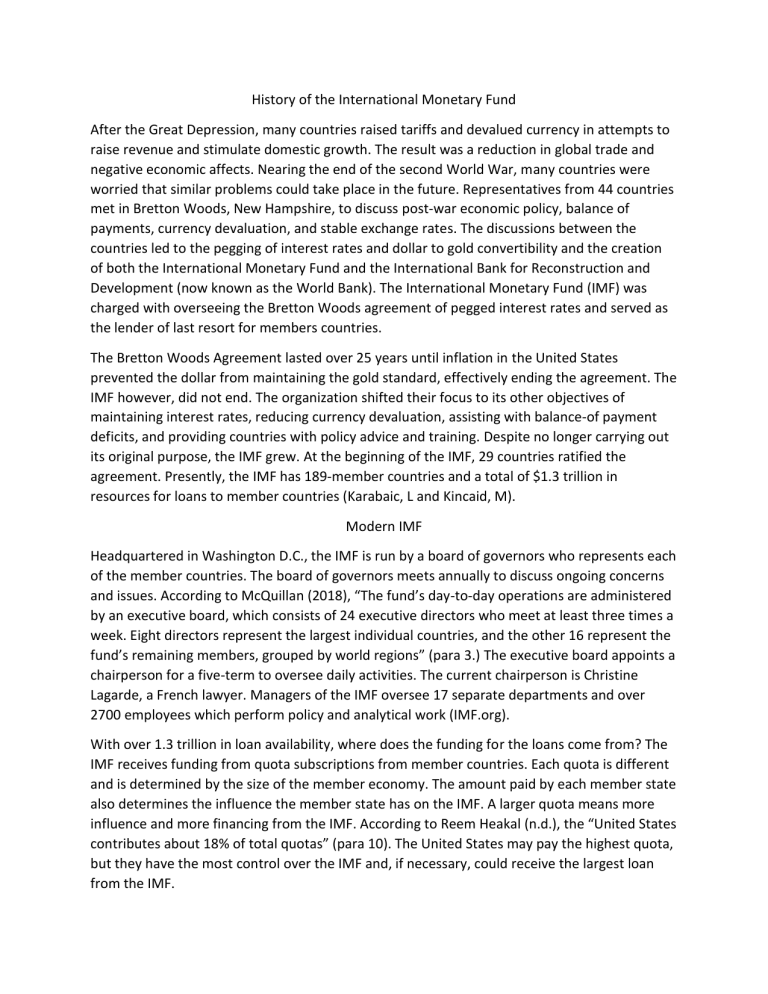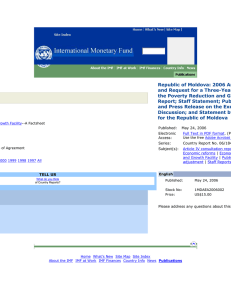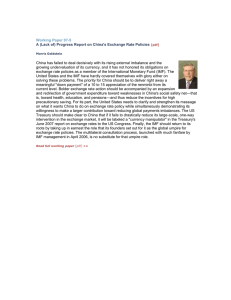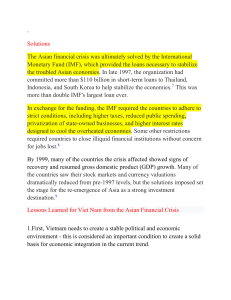History and Impact of the International Monetary Fund (IMF)
advertisement

History of the International Monetary Fund After the Great Depression, many countries raised tariffs and devalued currency in attempts to raise revenue and stimulate domestic growth. The result was a reduction in global trade and negative economic affects. Nearing the end of the second World War, many countries were worried that similar problems could take place in the future. Representatives from 44 countries met in Bretton Woods, New Hampshire, to discuss post-war economic policy, balance of payments, currency devaluation, and stable exchange rates. The discussions between the countries led to the pegging of interest rates and dollar to gold convertibility and the creation of both the International Monetary Fund and the International Bank for Reconstruction and Development (now known as the World Bank). The International Monetary Fund (IMF) was charged with overseeing the Bretton Woods agreement of pegged interest rates and served as the lender of last resort for members countries. The Bretton Woods Agreement lasted over 25 years until inflation in the United States prevented the dollar from maintaining the gold standard, effectively ending the agreement. The IMF however, did not end. The organization shifted their focus to its other objectives of maintaining interest rates, reducing currency devaluation, assisting with balance-of payment deficits, and providing countries with policy advice and training. Despite no longer carrying out its original purpose, the IMF grew. At the beginning of the IMF, 29 countries ratified the agreement. Presently, the IMF has 189-member countries and a total of $1.3 trillion in resources for loans to member countries (Karabaic, L and Kincaid, M). Modern IMF Headquartered in Washington D.C., the IMF is run by a board of governors who represents each of the member countries. The board of governors meets annually to discuss ongoing concerns and issues. According to McQuillan (2018), “The fund’s day-to-day operations are administered by an executive board, which consists of 24 executive directors who meet at least three times a week. Eight directors represent the largest individual countries, and the other 16 represent the fund’s remaining members, grouped by world regions” (para 3.) The executive board appoints a chairperson for a five-term to oversee daily activities. The current chairperson is Christine Lagarde, a French lawyer. Managers of the IMF oversee 17 separate departments and over 2700 employees which perform policy and analytical work (IMF.org). With over 1.3 trillion in loan availability, where does the funding for the loans come from? The IMF receives funding from quota subscriptions from member countries. Each quota is different and is determined by the size of the member economy. The amount paid by each member state also determines the influence the member state has on the IMF. A larger quota means more influence and more financing from the IMF. According to Reem Heakal (n.d.), the “United States contributes about 18% of total quotas” (para 10). The United States may pay the highest quota, but they have the most control over the IMF and, if necessary, could receive the largest loan from the IMF. Special Drawing Rights The unit of account of the IMF is known as Special Drawing Rights (SDRs). SDRs are not a currency or a claim on the IMF, but a potential claim on freely useable currencies of IMF member states. SDRs are interest bearing. The value of an SDR is determined daily, and the interest rate is determined on a weekly basis. SDRs can be purchased or sold on the open market. Currently, over 200 billion in SDR has been given to member states (equivalent to about 291 billion in US dollars). Accomplishments of the IMF With 2700 staff members and over $1 trillion in resources, the IMF is equipped to handle economic problems of member states. According to the IMF (2018), the IMF ensures international stability in three ways: “Keeping track of the global economy and the economies of member countries; lending to counties with balance of payments difficulties; and giving practical help to members”. Using these tools, the IMF has helped many member states, including Vietnam, Ireland, and Colombia. Vietnam Vietnam was one of the member states which joined the IMF at an early stage. During the Vietnam war, the country suffered politically and economically. The United States, one of the largest exporters from Vietnam, ceased trade relations due to the war. Other countries followed suit, significantly hurting the country. It was not till 1994 under President Bill Clinton directive that the United States began trade with Vietnam again. Meanwhile, inflation ran up to 400 percent, and the Vietnam economy struggled to produce basic consumer goods (IMF, 2018). Beset with economic difficulties, Vietnam began a series of economic reforms. Vietnam also sought the help of the IMF. The IMF lent Vietnam two loans, totaling about 435 SDR million (IMF, 2017). The IMF also sent advisors to Vietnam to help with public administration, tax policy, central banking, statistics gathering, and assistance to boost the credit rating of Vietnam (IMF, 2018). Under the instruction of the IMF, private ownership was encouraged. Previously, agriculture in Vietnam was run by government farms. With private ownership of farms, workers had extra incentives to work harder and boost production. Businesses were given more freedom for company decisions. The growth in Vietnam raised attention around the world, and foreign investors began to look for opportunities within Vietnam. Samsung was one of these investors. The large corporation built multiple plants in Vietnam. Today, Samsung has invested $17.5 billion in Vietnam, employing over 150,000 people (IMF, 2018). Senior Expert for the Central Institute for Economic Management Vo Tri Thanh (2018) stated “Cooperation with the IMF has been very, very, important for the whole process of reform”. The transformation of Vietnam was drastic. From 1993 to 2014 over 40 million people were lifted out of poverty, per capita growth averaged 5.6 percent each year, and people in Vietnam are better educated and can expect to live longer than citizens of most countries with comparable income levels (IMF, 2018). Ireland Like the United States, Ireland faced a construction and mortgage crisis in 2007. In the late 1990s, the economy of Ireland was booming. Economic growth was averaging more than 6 percent each year, unemployment figures were decreasing, and income was rising (IMF, 2018). The flourishing economic times led to a spending spree among individuals, especially for new housing. Competition among banks for mortgages caused lowered lending standards. Coupled with inadequate regulation, a bubble was created. Since it was easier to obtain lending, businesses began to expand, real estate property prices rose drastically, and many individuals purchased multiple houses. Lending policy was so high that bank assets exploded to a value five times higher than Ireland’s GDP (IMF, 2018). Finally, the demand for housing and new property began to slow. Housing prices began to fall, and construction was reduced, putting tens of thousands of people out of work. Combined with the global effects of the United States Great Recession, the Ireland economy was in trouble. To reduce the crisis, the government of Ireland stepped in and backed the loans made by 6 major banks in Ireland. In just two years, the Ireland government spent 46 billion euros into its banks (IMF, 2018). For a small period, the bailout prevented disaster. However, Ireland began to feel the effects of a global economy. Europe was in the middle of a crisis, causing Ireland to further suffer. The country began to rely on loans from the European Central Bank. As their debt rose, their creditworthiness suffered. Ireland sought the help of the IMF. Together with the European Commission, the IMF provided loans totaling 67.5 billion euros, about 40 percent of Ireland’s economy (IMF, 2018). A commission from the IMF and European Central Bank traveled to Ireland to discuss economic policy for Ireland with the goal of stabilizing the banking system and restoring investor confidence in the country. Under IMF and European Central Bank instructions, Ireland helped banks process the bad loans and promote payment plans for delinquent accounts. By 2013, the Allied Irish Bank and Bank of Ireland returned profits again. Secondly, the IMF helped Ireland with their large budget deficit. The IMF created a plan to raise funding for Ireland to pay toward their debt without endangering low income individuals or basic services such as welfare. The plan involved additional taxes and less government spending. The combination totaled 8 percent of GDP (IMF, 2018). Eventually, the Ireland economy improved, and the effects of the crisis diminished. Colombia The case of Colombia is a perfect poster child for the need of the IMF. Unlike the previous examples with Vietnam and Ireland, Colombia faced not only economic difficulties, but also safety concerns. The Revolutionary Armed Forces of Colombia (FARC), are rebels in Colombia. Farc was known for kidnaps, killings, and attacks. In 2016, Colombian President Juan Manuel Santos signed a peace deal with the leader of the rebels to end the fighting that had left over 220,000 people dead and 6 million people displaced from their homes (New York Times, 2018). In exchange for the rebels putting down their arms, the government agreed to build roads, schools, create jobs, build infrastructure and improve the quality of live in poor areas (IMF, 2018). However, the task of fulfilling the promises would be difficult. Colombia relies heavily on oil exports. Fluctuating prices of oil cause uncertainty in the marketplace. In 2014, oil prices fell, causing exports from oil to be cut in half, decreasing government revenue by 20 percent (IMF, 2018). The value of the Colombian peso decreased, and Colombia developed a serious trade deficit. When inflation began to rise, the Colombian government sought the IMF for help. The IMF had a previous record with Colombia. In 1999, Colombia sought a received a $2.7 billion loan to help overcome a recession. The IMF also assisted with economic reform to help Colombia prepare for tumultuous economic periods. The assistance boosted the international reputation of Colombia. According to former deputy finance minister Andres Escobar (2018), “The agreement with the Monetary Fund at that time helped Colombia earn the credibility of the international markets”. In 2009, Colombia qualified for a $10.5 billion credit line from the IMF. However, Colombia never withdrew any of those funds. The situation in 2016 was trickier than the previous encounters. If the assistance from the IMF failed, the FARC rebels could renege on their end of the peace deal. Facing a severe trade deficit, Colombia needed to generate revenue. Taxes were already high, but tax evasion was prevalent in Colombia. Using technical advice from the IMF, Colombia created a program which simplified and lowered corporate taxes, while providing training for tax officials and increasing penalties for tax evasion (IMF, 2018). The Colombian government made sure that opportunities for investment were created in low income areas. With chances to work, the rebels could put away their guns and find jobs and prosperity. Criticisms of the IMF Many have claimed that despite the accomplishments of the IMF, the fund has often made matters worse. Popular criticisms include: Conditions of loans, blanket reforms, free market and neo liberal reform policy, lack of involvement, and supporting countries with poor human rights records. While it is understood that the fund cannot always be perfect, World Bank chief economist Joseph Stiglitz has stated that IMF programs have worsened economic crises in countries such as Korea and Argentina (globalpolicy.org, 2003). The most popular criticism of the IMF is the loan conditions attached the aid to member states. https://www.imf.org/en/Countries/VNM/vietnam-raising-millions-out-of-poverty https://www.investopedia.com/articles/03/030703.asp https://www.theguardian.com/world/2017/jun/27/colombia-farc-weapons-war-government https://www.nytimes.com/2018/09/18/world/americas/colombia-farc-peace.html https://www.globalpolicy.org/component/content/article/209/42785.html






